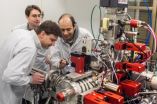(Press-News.org) Ultrasound technology could soon experience a significant upgrade that would enable it to produce high-quality, high-resolution images, thanks to the development of a new key material by a team of researchers that includes a professor in the Department of Biomedical Engineering at Texas A&M University.
The material, which converts ultrasound waves into optical signals that can be used to produce an image, is the result of a collaborative effort by Texas A&M Professor Vladislav Yakovlev and researchers from King's College London, The Queen's University of Belfast and the University of Massachusetts Lowell. Their findings appear in the current issue of "Advanced Materials."
The engineered material, known as a "metamaterial," offers significant advantages over conventional ultrasound technology, which generates images by converting ultrasound waves into electrical signals, Yakovlev explains. Although that technology has advanced throughout the years – think of the improvement in sonogram images – it is still largely constrained by bandwidth and sensitivity limitations, he says. These limitations, he adds, have been the chief obstacle when it comes to producing high-quality images that can serve as powerful diagnostic tools.
The metamaterial developed by Yakovlev and his colleagues is not subject to those limitations, primarily because it converts ultrasound waves into optical signals rather than electrical ones. The optical processing of the signal does not limit the bandwidth or sensitivity of the transducer (converter) – and that's important for producing highly detailed images, Yakovlev says.
"A high bandwidth allows you to sample the change of distance of the acoustic waves with a high precision," Yakovlev notes. "This translates into an image that shows greater detail. Greater sensitivity enables you to see deeper in tissue, suggesting we have the potential to generate images that might have previously not been possible with conventional ultrasound technology."
In other words, this new material may enable ultrasound devices to see what they haven't yet been able to see. That advancement could significantly bolster a technology that is employed in a variety of biomedical applications. In addition to being used for visualizing fetuses during routine and emergency care, ultrasound is used for diagnostic purposes in incidents of trauma and even as a means of breaking up tissue and accelerating the effects of drugs therapies.
While Yakovlev's research is not yet ready for integration into ultrasound technology, it has successfully demonstrated how conventional technology can be substantially improved by using the newly engineering material created by his team, he notes.
The material, he notes, consists of golden nanorods embedded in a polymer known as polypyrrole. An optical signal is sent into this material where it interacts with and is altered by incoming ultrasound waves before passing through the material. A detection device would then read the altered optical signal, analyzing the changes in its optical properties to process a higher resolution image, Yakovlev explains.
"We developed a material that would enable optical signal processing of ultrasound," Yakovlev says. "Nothing like this material exists in nature so we engineered a material that would provide the properties we needed. It has greater sensitivity and broader bandwidth. We can go from 0-150 MHz without sacrificing the sensitivity. Current technology typically experiences a substantial decline in sensitivity around 50 MHz.
"This metamaterial can efficiently convert an acoustic wave into an optical signal without limiting the bandwidth of the transducer, and its potential biomedical applications represent the first practical implementation of this metamaterial."
###
Yakovlev's collaborators are Wayne Dickson and Anatoly Zayats of King's College London; John McPhillips, Antony Murphy and Robert Pollard of The Queen's University of Belfast; and Viktor Podolskiy of the University of Massachusetts Lowell.
About Research at Texas A&M University:
As one of the world's leading research institutions, Texas A&M is in the vanguard in making significant contributions to the storehouse of knowledge, including that of science and technology. Research conducted at Texas A&M represents an annual investment of more than $700 million. That research creates new knowledge that provides basic, fundamental and applied contributions resulting in many cases in economic benefits to the state, nation and world.
Media contact:
Professor Vladislav Yakovlev at 979-458-2326 or yakovlev@tamu.edu or Ryan A. Garcia at 979-847-5833 or ryan.garcia99@tamu.edu.
More news about Texas A&M University, go to: http://tamutimes.tamu.edu/.
Follow us on Twitter at http://twitter.com/tamu/ END
This press release is available in German.
The microbiology team of David Berry, Alexander Loy and Michael Wagner from the Faculty of Life Sciences, in collaboration with scientists at the Max F. Perutz Laboratories (University of Vienna and the Medical University of Vienna) and with the help of NanoSIMS technology, has for the first time succeeded in directly observing microorganisms feeding on the intestinal mucosa. The results of this research project appear in the current issue of the prestigious journal "Proceedings of the National Academy of Sciences" (PNAS).
To ...
Homes in neighborhoods that incorporate protected open space command prices 20 to 29 percent higher than those without open space, according to a new study by a Colorado State University multidisciplinary research team that included Wildlife Conservation Society scientist, Sarah Reed.
Conservation development is an approach to the design, construction, and stewardship of a development that protects natural resources while also providing social and economic benefits to people. The properties in this study specifically incorporated protected open space into the design of ...
PASADENA, Calif.—If you could lick the surface of Jupiter's icy moon Europa, you would actually be sampling a bit of the ocean beneath. So says Mike Brown, an astronomer at the California Institute of Technology (Caltech). Brown—known as the Pluto killer for discovering a Kuiper-belt object that led to the demotion of Pluto from planetary status—and Kevin Hand from the Jet Propulsion Laboratory (JPL) have found the strongest evidence yet that salty water from the vast liquid ocean beneath Europa's frozen exterior actually makes its way to the surface.
The finding, based ...
MINNEAPOLIS/ST. PAUL (March 4, 2013) – Cesarean delivery is the most common surgery in the United States, performed on 1.67 million American women annually. Yet hospital cesarean rates vary widely according to new research from the University of Minnesota's School of Public Health.
The latest study, appearing today in Health Affairs, shows that cesarean delivery rates varied tenfold across U.S. hospitals, from 7.1 percent to 69.9 percent.
To arrive at their results, School of Public Health researchers examined hospital discharge data from a representative sample ...
March 5. 2013 -- Survey results released today indicate that satisfaction and usability ratings for certified electronic health records (EHRs) have decreased since 2010 among clinicians across a range of indicators. Overall, user satisfaction fell 12 percent from 2010 to 2012. Users who are "very dissatisfied" increased 10 percent during the same time period.
The American College of Physicians (ACP) and AmericanEHR Partners revealed the findings in a presentation, "Challenges with Meaningful Use: EHR Satisfaction & Usability Diminishing," at the 2013 HIMSS Conference ...
SALT LAKE CITY – Researchers have identified a critical protein role in the metastasis of melanoma, the most serious form of skin cancer. Inhibition of the protein known as adenosine diphosphate ribosylation factor 6 (ARF6) reduces the spread of melanoma to the lungs in mice, according to a study published in the March 5 issue of Science Signaling online, suggesting that targeting ARF6 may be an effective approach to preventing melanoma metastasis.
Melanoma is the sixth most common cancer in the United States. Approximately one in 50 people will develop melanoma in their ...
AURORA, Colo. (March 5, 2013) – Researchers have discovered that deleting a specific gene in mice prevents them from becoming obese even on a high fat diet, a finding they believe may be replicated in humans.
"When fed a diet that induces obesity these mice don't get fat," said Prof. James McManaman, Ph.D., lead author of the study and vice-chairman of research for Obstetrics and Gynecology at the University of Colorado School of Medicine. "It may be possible to duplicate this in humans using existing technology that targets this specific gene."
The two-year study, ...
This press release is available in French.
Montreal, March 5, 2013 – Pulp and paper producers are among Canada's most important industries and also one of the largest producers of wastewater. Estimating the greenhouse gas emissions in this wastewater has become a priority for the industry.
Until now, greenhouse gas emission estimates have been limited by the mathematical models used to predict them. Researchers at Concordia University have recently developed a new dynamic method to better predict the emission content of these gases. Their findings, published in Environmental ...
HOUSTON -- (March 4, 2013) – Introductions at a party seemingly go in one ear and out the other. However, if you meet someone two or three times during the party, you are more likely to remember his or her name. Your brain has taken a short-term memory – the introduction – and converted it into a long-term one. The molecular key to this activity is mTORC2 (mammalian target of rapamycin complex 2), according to researchers at Baylor College of Medicine (http://www.bcm.edu) in an article that appeared online in the journal Nature Neuroscience (http://www.nature.com/neuro/journal/vaop/ncurrent/full/nn.3351.html).
"Memory ...
Lower back pain is a common complaint, and treatment often requires many hours of physical therapy over multiple weekly clinic visits — a costly commitment. Now Dr. Michal Katz-Leurer of Tel Aviv University's Stanley Steyer School of Health Professions at the Sackler Faculty of Medicine says that a simple aerobic walking program is as effective in alleviating lower back pain as muscle strengthening programs that require specialized equipment in rehabilitation clinics. The program includes walking two to three times a week for a period of 20 to 40 minutes,
Dr. Katz-Leurer ...


